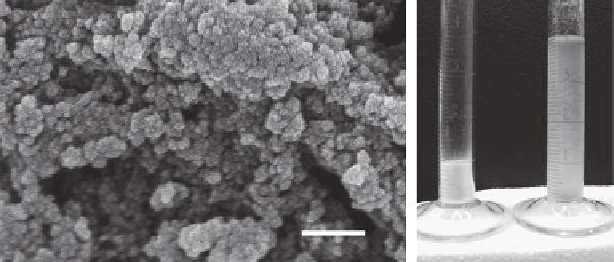Environmental Engineering Reference
In-Depth Information
(a)
(b)
100 nm
FIGURE 7.8
(a) Electron micrograph of swellable organosilica showing lexible interconnected nanoparticulate network.
(b) Organosilica before and after being exposed to organic solvent to induce swelling. Gravimetric gain, 680%;
volume gain, 400%.
1200
1000
800
600
400
200
0
0
0.2
0.4
Relative pressure (Ps/Po)
0.6
0.8
1
FIGURE 7.9
Nitrogen absorption-desorption isotherm for swellable organosilica in the nonswollen state.
respectively. Nitrogen porosimetry measurements indicate that the material is mesopo-
rous (Figure 7.9). Swellable organosilica commercially available as Osorb
®
does not absorb
water, but has high afinity for dissolved and disperse organics.
7.4.3.2 Removal of Dispersed and Dissolved Oil
The presence of surfactants in bilge water leads to colloidal systems that are dificult to treat.
A highly oleophilic version of swellable organosilica, Osorb-EB, was developed that possesses
mesoscale pores 50-150 nm in diameter to treat emulsiied oil. The larger pore size aids in the
capture of small emulsiied oil droplets. Emulsiied oil was prepared by adding 1000 ppm
fuel oil to water containing 0.05% w/v undecyl glucoside nonionic surfactant. In batch-scale
experiments, 1.5% w/v Osorb-EB was combined with the oil-water mixture and mixed by
ultrasonication for 5 s. After separating the media by lotation, the oil content was measured
by gas chromatography mass spectrometry (Figure 7.10) indicating that the total petroleum
hydrocarbon constant, both free and dissolved, dropped from 850 to <5 ppm. Total organic


